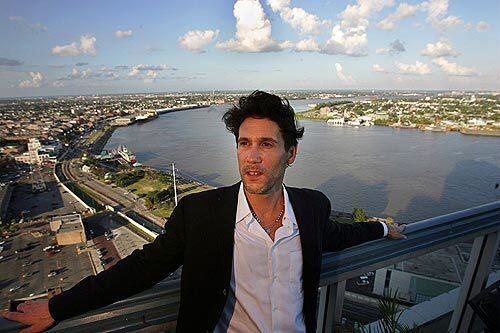New Orleans: Two years later

Richard Mills says he used to pull in more than $1,000 a day parading as a jester down New Orleans’ busy streets. “Now, with not many tourists I’m lucky to earn enough for lunch,” he says. Lawmakers recently passed a package of tax incentives that they hope will invigorate New Orleans’ entertainment scene. (Spencer Weiner / LAT)

The shattered window of a closed elementary school frames homes in the Holy Cross neighborhood, part of the Lower Ninth Ward that is slowly being rebuilt. One project on tap for the area is an environmentally friendly housing complex. (Spencer Weiner / LAT)

Adam Crochet and his girlfriend Boyanna Trayanova moved into their new home in the Upper Ninth Ward in an area dubbed the “musicians’ village.” Eighty colorful homes were built by the local branch of Habitat for Humanity and are being sold to musicians who lost their homes in the hurricane. (Spencer Weiner / LAT)

Teacher Eric Kugler tends the garden at Samuel J. Green Charter School a few days before the start of classes. The New Orleans campus boasts an Edible Schoolyard, a concept started in Berkeley by restaurateur Alice Waters that’s geared toward giving kids lessons not just in healthful eating habits, but expands into the classroom as hands-on experience in biology, math and social sciences. (Spencer Weiner / LAT)
Advertisement

When Katrina damaged a St. Bernard Parish neighborhood, a group of residents moved their families en masse to a suburb on the other side of Lake Pontchartrain. Children, most of whom knew each other from the old neighborhood, gather outside their new homes, about an hour outside of New Orleans. (Spencer Weiner / LAT)

New Orleans resident John Griffin picks a screen door at the Green Project’s recycled materials store. The nonprofit agency salvaged materials from homes damaged or destroyed in the hurricane and created a storefront where residents could shop for discounted, and possibly historic, items. (Spencer Weiner / LAT)

John Knost, shown at his French Quarter apartment, came up with an innovative idea to protect homes from flooding after growing frustrated with the government’s plans on making New Orleans safer. The patent-pending Knost Flood Wall features a concrete floodwall system coated with a waterproof sealant that’s buried and set a few yards away from the levees to serve as a backup. Although the government has yet to embrace the concept, Knost says federal engineers have sent him revisions. (Spencer Weiner / LAT)

Sean Cummings is shown above the stretch of the Mississippi River along downtown that his agency, the New Orleans Building Corp., plans to revitalize. The proposal includes a five-mile riverfront development that will feature jogging and biking trails, hotels and a performance venue. (Spencer Weiner / LAT)
Advertisement

Commuters and tourists watch the sun set over New Orleans from the deck of the Canal Street ferry. The street used to be considered the Champs-Elysees of the American South once upon a time, but it’s now mostly home to T-shirt shops and empty storefronts. Officials hope to change all that with a tax incentive package that’s focused on making New Orleans a market for high-end live entertainment. (Spencer Weiner / LAT)



